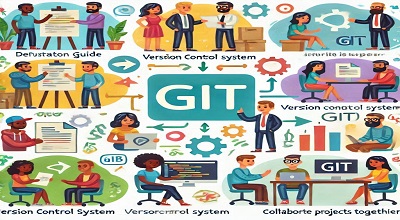Introduction to Git
Git: In the realm of software development, efficient collaboration and version control are indispensable. Git, a distributed version control system (DVCS), revolutionized the way developers manage and collaborate on projects. Developed by Linus Torvalds in 2005, Gi t has become the de facto standard for version control due to its speed, flexibility, and robust branching model.
What is Git?
Git is a distributed version control system designed to track changes in source code during software development. Unlike centralized version control systems, G it stores the entire history of a project on each user’s local machine, enabling seamless collaboration and offline work. Git’s distributed nature empowers developers to work independently, yet merge their changes efficiently.
Key Concepts of Git
- Repository (Repo): A repository is a collection of files and directories managed by Gi t. It holds the project’s entire history and serves as a centralized hub for collaboration.
- Commit: A commit represents a snapshot of the repository at a specific point in time. It captures changes made to files, along with a descriptive message explaining the modifications.
- Branch: A branch is a parallel version of the repository that diverges from the main codebase. Developers create branches to work on new features or bug fixes without affecting the main code until changes are ready for integration.
- Merge: Merging combines changes from different branches into a single branch, typically the main branch (e.g., master or main). Gi t automatically resolves conflicts between conflicting changes during the merge process.
- Pull Request (PR): In Git-based collaboration workflows, a pull request is a mechanism for proposing changes to a repository. It allows developers to review, discuss, and validate modifications before merging them into the main codebase.
How to Use Git?
Install Git: Begin by installing Gi t on your system. Gi t is available for Windows, macOS, Linux, and various Unix-like systems. You can download the installer from the official G it website and follow the installation instructions.
Configure Gi t: After installation, configure Gi t with your name and email address using the following commands:

Create a Repository: To initiate a new Git repository, navigate to your project directory and run the command:

Add and Commit Changes: Add files to the staging area using the git add command, and commit changes to the repository using g it commit:

Create and Manage Branches: Create a new branch to work on a feature or bug fix:

Switch between branches using git checkout <branch_name> and list existing branches with gi t branch.
Merge Changes: Once your changes are complete, merge them into the main branch:

Collaborate with Remote Repositories: Connect your local repository to a remote repository hosted on platforms like GitHub, GitLab, or Bitbucket:

Push commits to the remote repository with git push and fetch updates with gi t pull.
Manage Pull Requests: When collaborating with others, create pull requests to propose and review changes:
- Push your branch to the remote repository: git push origin <branch_name>
- Navigate to the repository on the hosting platform and create a pull request.
- Review feedback, address comments, and merge the pull request once approved.
Resolve Conflicts: In case of merge conflicts, manually resolve differences between conflicting changes in affected files, then commit the resolved changes:

Conclusion
Git empowers developers to efficiently manage and collaborate on projects of any scale. By understanding its fundamental concepts and workflows, you can leverage Git to streamline your development process, foster collaboration, and ensure the integrity of your codebase. Embrace Git’s distributed nature and versatile features to unleash your team’s full potential in software development endeavors.
